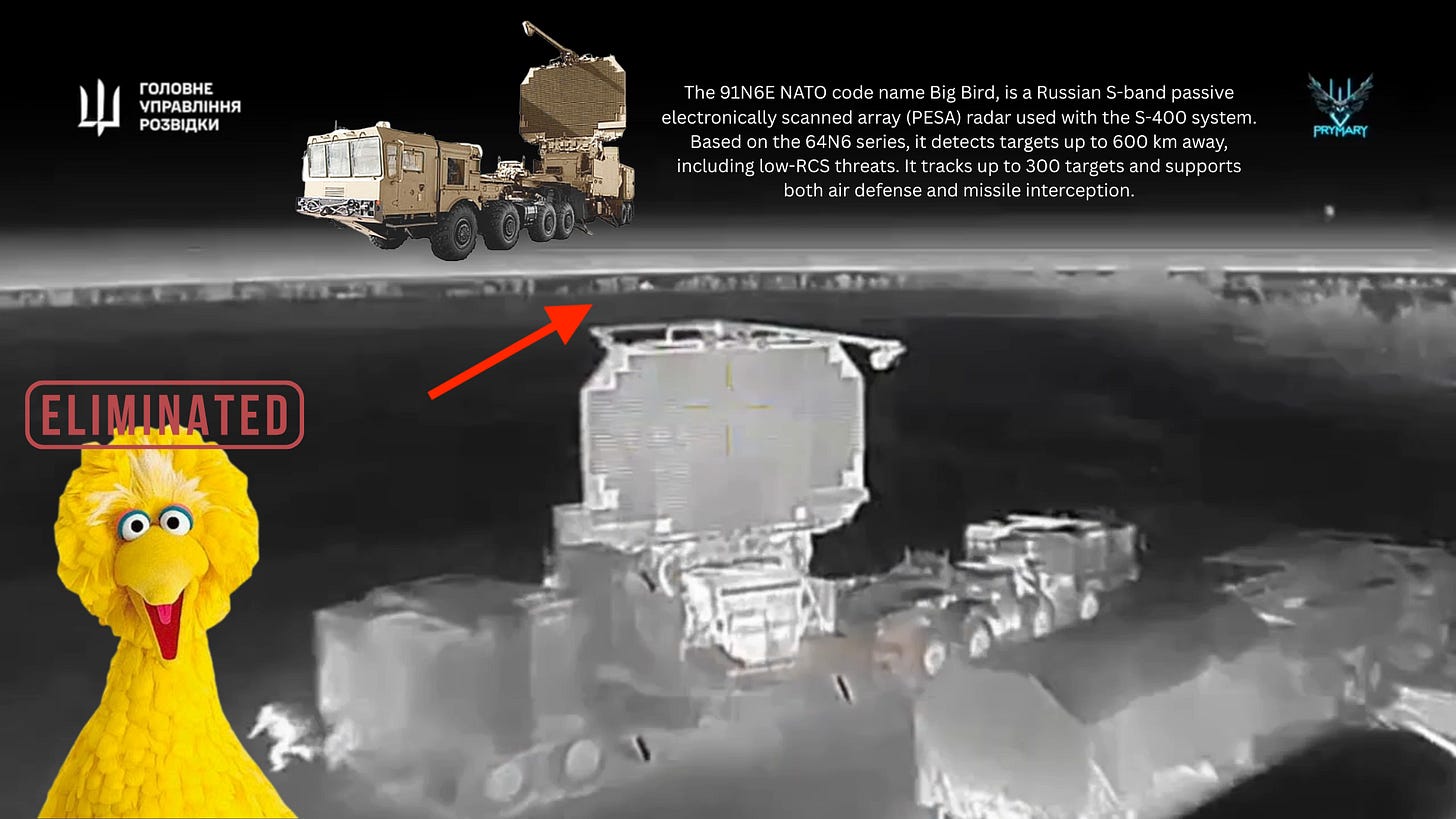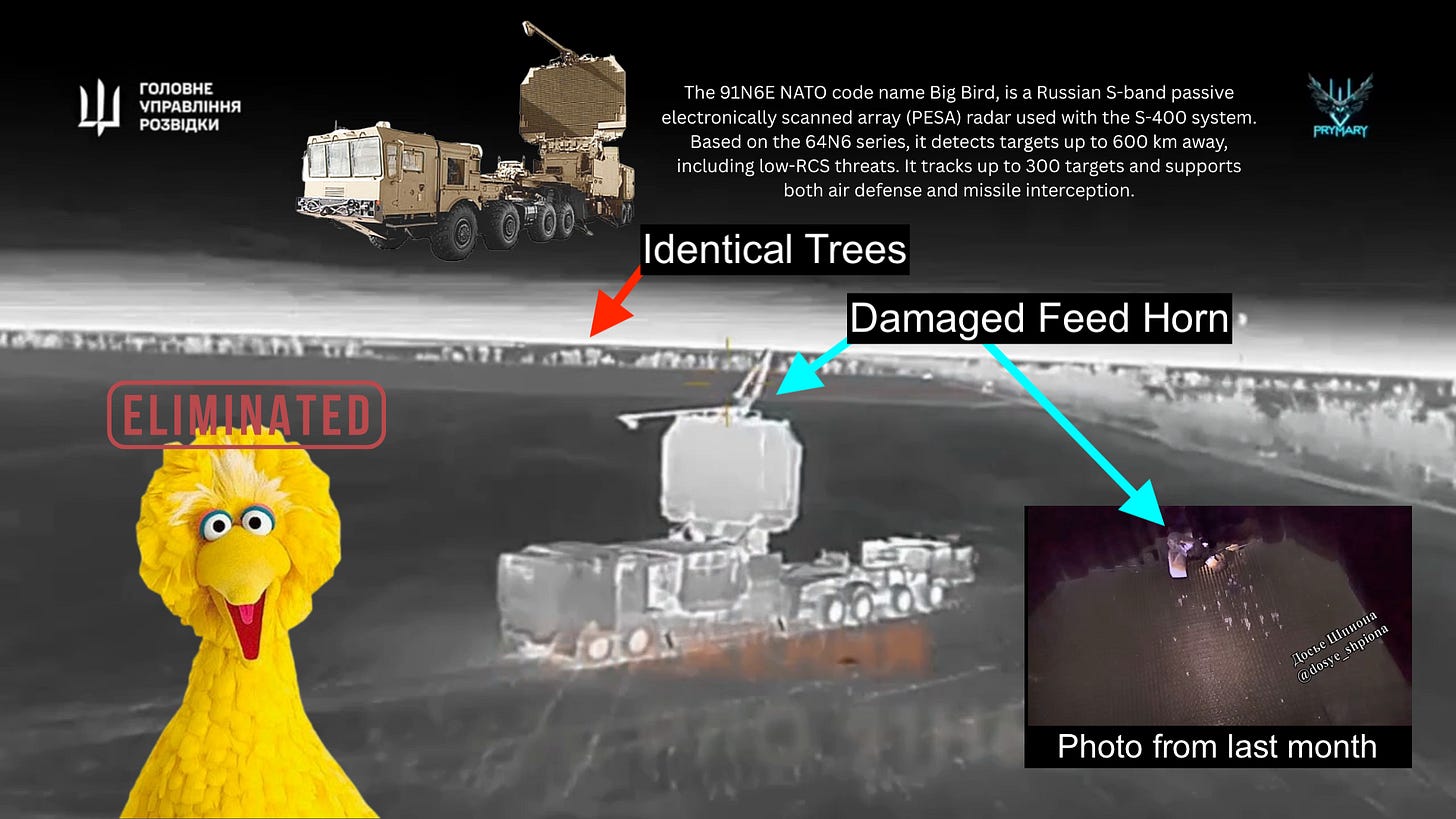Striking the Eyes: Ukraine Targets Russia's 91N6E 'Big Bird' Radars in Crimea
How Ukraine is degrading Russia’s S-400 command structure—one radar at a time!
On June 26, 2025, Ukraine’s Military Intelligence Directorate (GUR) claimed responsibility for destroying two 91N6E “Big Bird” radars in Russian-occupied Crimea. These radars are critical to Russia’s S-400 air defense system, serving as its long-range detection backbone. By targeting these assets, Ukraine aims to disrupt Russia’s air defense network, creating vulnerabilities in its control over Crimea’s airspace.

What is the 91N6E “Big Bird” Radar?
The 91N6E is a passive electronically scanned array (PESA) radar mounted on an 8×8 MZKT truck, designed for long-range detection and tracking. It’s the regimental-level “eyes” of the S-400, feeding early warning and targeting data to subordinate battery radars like the 96L6 and 92N6.
Key Specs:
Range: ~600 km for large targets
Role: Detects and tracks stealth aircraft, cruise missiles, UAVs, and more
Coverage: 360° in the S-band
Weakness: Emits a strong, non-low-probability-of-intercept (non-LPI) signal, making it easy to detect and target
Lineage: Evolved from the 64N6 radar used in the S-300P system
Sources: radartutorial.eu, AusAirPower.net
Why This Matters
The 91N6E is the nerve center of an S-400 regiment. It coordinates battery-level radars, enabling precise targeting and efficient coverage. Without it, subordinate radars must switch to wide-area scanning—a task they’re not optimized for. This slows reaction times, reduces accuracy, and exposes gaps in coverage.
Think of it like cutting power to the main searchlight in a perimeter defense. The other guards still have flashlights, but now they have to sweep wider arcs, react slower, and they miss things they’d normally never let through. Nuke’s
Impact:
Disrupted Coordination: Battery radars operate independently, reducing efficiency.
Increased Vulnerability: Gaps in coverage make it easier for Ukrainian drones, missiles, or aircraft to penetrate.
Strategic Message: Ukraine’s GUR demonstrates precision and long-range strike capability against high-value targets.
The Strikes: A Closer Look
GUR’s “Prymary” drone unit released footage on Telegram showing a drone strike on a 91N6E radar. The video captures two moments:
Pre-Strike: The radar’s feed horn and support structure are intact.
Post-Strike: The feed horn is bent, and the support arm is deformed.
A photo from April 30, 2025, circulated online, showing a damaged 91N6E with a punctured array and missing feed horn support. The June footage may depict the same radar, suggesting a “double tap” tactic: an initial strike to damage the radar, followed by a second to ensure its destruction.
Possibilities:
Same Radar: The April photo and June footage show one radar hit twice, with GUR releasing delayed footage to amplify the June claim.
Different Radars: The similar damage patterns suggest GUR has a precise targeting strategy, focusing on the radar’s feed horn to disable it.

Caution: GUR claims two radars were destroyed, but the footage only clearly shows one. The second radar has the generator or command vehicle moved. More evidence is needed to confirm the second kill.
Sources: Telegram (@voynareal), YouTube (April 30, 2025)
GUR’s Targeting Strategy
The strikes reveal a deliberate approach:
Locate: Identify the 91N6E using its strong radar emissions.
Strike: Target the feed horn and array to disable detection.
Confirm: Use drones or loitering munitions to verify destruction.
This isn’t about luck—it’s a calculated effort to blind Russia’s integrated air defense system (IADS) in Crimea.
Does This Cripple Russia’s Defenses?
Not quite. Russia’s IADS is built for redundancy, with overlapping radar coverage, backup systems, and mobile assets. Losing one or two 91N6E radars doesn’t collapse the network. However, it forces the system to compensate, straining resources and creating exploitable weaknesses.
Effects:
Overloaded Batteries: Subordinate radars take on heavier detection roles, reducing their effectiveness.
Slower Response: Intercepts become less precise, increasing the chance of missed threats.
Pressure on Redundancy: Repeated strikes could erode Russia’s ability to replace or repair high-value assets.
While Russia’s ground-based air defenses (GBAD) have proven resilient, sustained Ukrainian strikes could gradually weaken the S-400’s dominance in Crimea, making it harder to maintain an impenetrable “anti-access bubble.”
What’s Next?
Ukraine’s GUR is signaling a shift toward targeting high-value air defense nodes, not just launchers. This approach maximizes operational impact, exposing cracks in Russia’s air defense network. If GUR continues to refine its long-range drone strikes, Russia may face increasing pressure to protect or relocate its radar assets.
For now, the loss of one—or possibly two—91N6E radars is a tactical win for Ukraine, but not a knockout blow. Russia’s IADS remains formidable, but its resilience is being tested.
Sources:
Telegram: GUR 'Prymary' Drone Strike on S-400 Radar Assets
Watch on Telegram
Posted June 26, 2025 by @voynareal — The video shows strikes on key components of a Russian S-400 system in occupied Crimea, allegedly by Ukraine’s GUR “Prymary” drone team.
Original caption (AI translated):
GUR's “Prymary” drones continue to haunt Russian forces in Crimea. The video shows fiery strikes on critical components of the S-400 “Triumf” air defense system.
Targets claimed destroyed:
Two 92N2E fire-control radars
Two 91N6E long-range detection radars
One S-400 launcher
Original caption:
Дрони ГУР «Примари» продовжуєть кошмарити русню в Криму: на відео – кадри вогняної роботи по критично важливим системам ППО С-400 "Тріумф".
Розвідники уразили:
дві багатофункціональні РЛС управління 92Н2Е;
дві РЛС виявлення 91Н6Е;
пускова установка комплексу С-400.
YouTube: S-400 91N6 radar Damaged by Drones in Crimea
Watch on YouTube
Posted April 30, 2025 — Possibly shows the same radar damaged in an earlier strike. Used here for visual comparison and timeline reconstruction.
radartutorial.eu – 91N6E Radar Overview
Technical reference on radar characteristics
AusAirPower.net – Russian IADS Structure
In-depth analysis of S-300/S-400 systems




